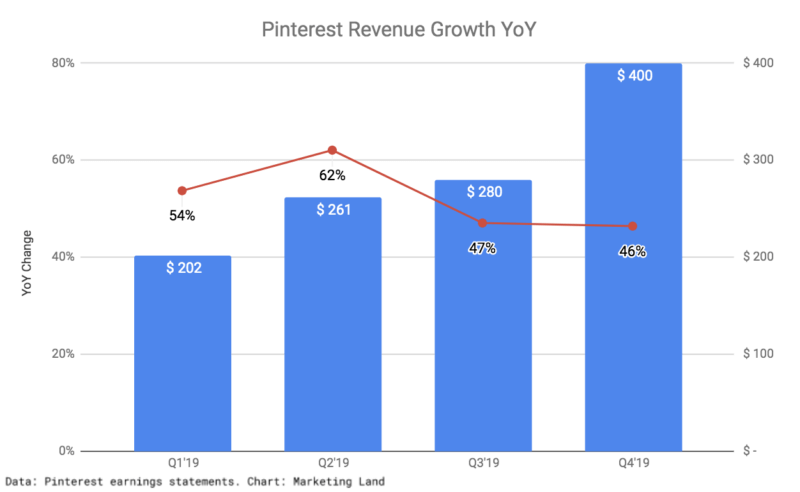Pinterest revenues reached $400 million for the fourth quarter of 2019, growing 46% year-over-year and exceeding analysts’ forecast of $371.2 million, the company reported Friday. Annual revenue surpassed $1 billion, to reach $1.14 billion – an increase of 51% over 2018.

Audience growth. Global monthly active users (MAUs) grew 26% year-over-year reaching 335 million, up from 332 million in 2018. In its U.S. market, MAUs increased 8% to 88 million, up from 87 million from the previous year.

International growth. The fourth quarter closed out an impressive year for Pinterest on the global front, with the company expanding into 21 new international advertising markets, according to Pinterest’s CFO Todd Morgenfeld. Revenues from those markets grew from 6% to 13% of total revenue for the fourth quarter – a result of the platform’s increased focus on ad solutions for global advertisers, the company said.
Measurement and Shopping ads. Pinterest CEO Ben Silbermann indicated that the platform’s 2019 investment in “properly implemented measurement” tools has been a major driver of its fourth-quarter revenue. Conversion campaigns – which advertisers can use with Checkout, Signup, Lead, or Add to Cart – grew 150% last quarter, and saw “a 2.5 times improvement in attributable conversions that we saw this Q4 versus a year ago,” said Morgenfeld. In the second half of 2019, revenue from Shopping ads more than doubled compared to the first half of the year; the number of monthly advertisers buying those types of ads grew by 125%.
Why we care. Pinterest’s better-than-expected Q4 growth reflects the company’s focus on creating more robust, scalable ad products for advertisers both in the U.S. and in global markets. “The company saw 3x increase in the percentage of people saving their ads this season. The key here is making sure ads are relevant to our pinners’ interests, projects, and plans,” Silbermann explained. In 2020, Silbermann said scaling Pinterest’s ads business will continue to be a key priority with a focus on capturing more mid-size international advertisers.
Looking ahead, advertisers can expect Pinterest to expand the types of brands it works with, while improving enablement tools and increasing the volume of ads on the platform. “To serve ads that are relevant to the incredibly diverse range of ideas being explored on Pinterest, we need to increase the number of ads in our system, by bringing more advertisers and building tools that meet their needs,” Silbermann said.

